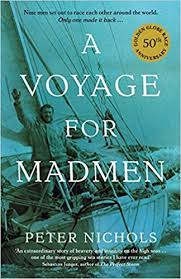A Voyage for Madmen by Peter Nichols *** (of 4)
In 1968 the United States was nearing its first landing on the moon. It was also the year that a British newspaper offered a 5,000 pound reward for the first sailor to circumnavigate the world, solo, without stopping. Another 5,000 pounds was to be awarded for the fastest trip. We were exploring the far reaches of space; simultaneously, humans were testing endurance here on earth. Nine sailors set out from England heading east around Cape Horn, south below the southern reaches of Australia, past South America's Cape of Good Hope and then north up the Atlantic back to England.
Each sailor hoped they were carrying sufficient water, food, and supplies to repair any damage that was sure to occur on a boat sailing so far south it had to endure the Roaring Forties. Below the two Capes, the sea surrounding Antarctica is unencumbered by any land masses. Storms have unmitigated fetch over which to whip up gale force winds and towering waves.
Beyond the elements, sailors had to endure endless weeks and months alone, out of contact or eyesight with land, ships, or humans.
Robin Knox Johnston in this boat was the only sailor to complete the voyage.
A Voyage for Madmen does its best to fit the genre of ocean adventures. As a third person narrative mostly meets the bill, building a timeline from extant ship logs. What it lacks in the immediacy of a first-person account it makes up for with persistent reminders of just how difficult it is to be on one's own in a treacherous and wide open sea for months at a time.
Each sailor hoped they were carrying sufficient water, food, and supplies to repair any damage that was sure to occur on a boat sailing so far south it had to endure the Roaring Forties. Below the two Capes, the sea surrounding Antarctica is unencumbered by any land masses. Storms have unmitigated fetch over which to whip up gale force winds and towering waves.
Beyond the elements, sailors had to endure endless weeks and months alone, out of contact or eyesight with land, ships, or humans.
Robin Knox Johnston in this boat was the only sailor to complete the voyage.
 |
| Robin Knox-Johnston aboard his 32-foot Suhali in the Atlantic near the end of his circumnavigation of the globe. Link. |

Comments
Post a Comment